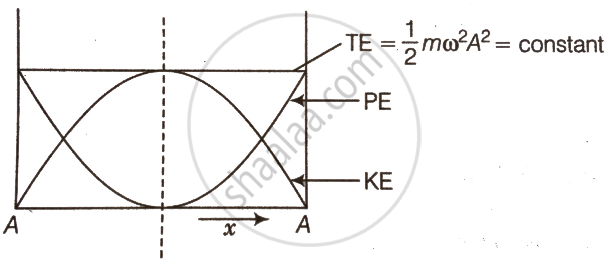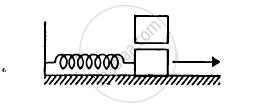Advertisements
Advertisements
प्रश्न
Draw a graph to show the variation of P.E., K.E. and total energy of a simple harmonic oscillator with displacement.
उत्तर
The potential energy (PE) of a simple harmonic oscillator is = `1/2 kx^2`
= `1/2 mω^2x^2` .....(i)
Where, k = force constant = `mω^2`
When PE is plotted against displacement x, we will obtain a parabola.
When x = 0, PE = 0
When x = ± A, PE = maximum = `1/2 mω^2A^2`
KE of a simple harmonic oscillator = `1/2 mv^2` .....`[∵ v = ωsqrt(A^2 - x^2)]`
= `1/2 m[ωsqrt(A^2 - x^2)]^2`
= `1/2 mω^2(A^2 - x^2)` ......(ii)
This is also a parabola if plotting KE against displacement x.
i.e., KE = 0 at x = ± A
And KE = `1/2 mω^2A^2` at x = 0
Now, the total energy of the simple harmonic oscillator = PE + KE .......[Using equations (i) and (ii)]
= `1/2 mω^2x^2 + 1/2 mω^2 (A^2 - x^2)`
= `1/2 mω^2x^2 + 1/2 mω^2A^2 - 1/2 mω^2x^2`
TE = `1/2 mω^2A^2`
Which is constant and does not depend on x.
Plotting under the above guidelines KE, PE and TE versus displacement x-graph as follows

APPEARS IN
संबंधित प्रश्न
A particle executes simple harmonic motion with an amplitude of 10 cm. At what distance from the mean position are the kinetic and potential energies equal?
A block suspended from a vertical spring is in equilibrium. Show that the extension of the spring equals the length of an equivalent simple pendulum, i.e., a pendulum having frequency same as that of the block.
A block of mass 0.5 kg hanging from a vertical spring executes simple harmonic motion of amplitude 0.1 m and time period 0.314 s. Find the maximum force exerted by the spring on the block.
In following figure k = 100 N/m M = 1 kg and F = 10 N.
- Find the compression of the spring in the equilibrium position.
- A sharp blow by some external agent imparts a speed of 2 m/s to the block towards left. Find the sum of the potential energy of the spring and the kinetic energy of the block at this instant.
- Find the time period of the resulting simple harmonic motion.
- Find the amplitude.
- Write the potential energy of the spring when the block is at the left extreme.
- Write the potential energy of the spring when the block is at the right extreme.
The answer of b, e and f are different. Explain why this does not violate the principle of conservation of energy.

A 1 kg block is executing simple harmonic motion of amplitude 0.1 m on a smooth horizontal surface under the restoring force of a spring of spring constant 100 N/m. A block of mass 3 kg is gently placed on it at the instant it passes through the mean position. Assuming that the two blocks move together, find the frequency and the amplitude of the motion.

When a particle executing S.H.M oscillates with a frequency v, then the kinetic energy of the particle?
When the displacement of a particle executing simple harmonic motion is half its amplitude, the ratio of its kinetic energy to potential energy is ______.
If a body is executing simple harmonic motion and its current displacements is `sqrt3/2` times the amplitude from its mean position, then the ratio between potential energy and kinetic energy is:
Displacement versus time curve for a particle executing S.H.M. is shown in figure. Identify the points marked at which (i) velocity of the oscillator is zero, (ii) speed of the oscillator is maximum.

The total energy of a particle, executing simple harmonic motion is ______.
where x is the displacement from the mean position, hence total energy is independent of x.
